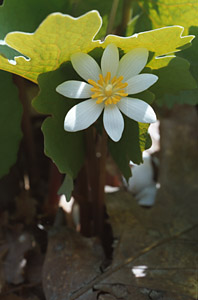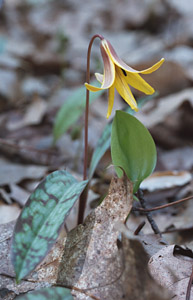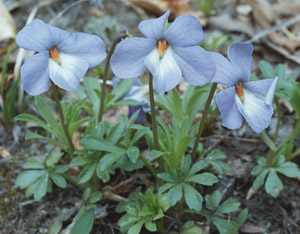
Westborough and the surrounding area offer numberous locations with walking trails. The
Westborough Reservoir
is among these and offers a diversity of wildflowers in a relatively small area. Described
here are wildflowers found at other locations in and around Westborough. Many of these are
part of the Westborough Charm Bracelet
project linking 26 miles of local trails. The Charm Bracelet site offers trail maps for many
local conservation areas.
Bloodroot, Poppy family (Papaveraceae), Native


|

Bloodroot owes its name to the acrid reddish sap in its stem and root. Native Americans and colonists used the sap to make a red-orange dye for clothing and baskets. Mixed with animal fat, the sap served as face paint for Native Americans. They also rubbed it on their skin as an insect repellent.
Native Americans had various medicinal uses for bloodroot, such as treating rheumatism with tea made from the root. They also put the sap on a lump of maple sugar and sucked it to alleviate sore throats, a remedy that colonists adopted. In American medicine of the past, the root provided an ingredient for cough syrup. In recent decades, an extract called sanguinarine has been used commercially as a plaque-fighting ingredient in toothpaste and mouthwash.
A member of the poppy family, bloodroot contains some of the same chemicals found in other plants in the
family, including the opium poppy. The root is considered toxic and should not be ingested.
Trout-lily or Dog Tooth Violet, Lily family (Liliaceae), Native

 |
 |
 |

The odd name trout-lily may come from the time of year that the plant blooms--early in spring, around trout season. Another explanation is that the name comes from the similarity of the mottled leaves to the pattern on the sides of certain trout. The camouflaging mottled pattern may also be responsible for another name, fawn lily.
The plant has two other unlikely names. One is dog tooth violet. Although the plant is a lily, not a violet, it may have acquired this name because it blooms when violets bloom. The description "dog tooth" may refer to the pointed end of the bulb-like corm from which the plant grows. The second unlikely name is adder's-tongue, which is possibly related to the lance-like shape of its two leaves, suggesting a forked tongue.
Trout-lily grows in dense beds, spreading as the bulb-like corms send down threads that form small new corms several inches underground. Young corms send out leaves and more corm-producing threads, but they do not bloom for several years. The whole network of threads and corms helps to hold the soil together in an area, preventing erosion. Eventually flowers produce seeds, many of which are distributed by ants. The seeds form new corms the following spring.
Young trout-lily leaves have been cooked as greens, and the corms, like the bulbs of many lilies,
have been cooked as a vegetable. Native Americans found medicinal uses for trout-lily, using root
tea for fevers, making poultices for sores and splinters, and even eating uncooked leaves for
contraception. Present-day research indicates that water extracts of the plant act against bacteria.
Birdfoot Violet, Violet family (Violaceae), Native


|

Birdfoot violet is capable of blooming a second time in a year, typically in the fall. The plants favor
sunny, dry, sandy locations.
| show TOC frame | Table of Contents | 
|
| A more printable copy may be found here. Our main wildflower site is found here. 

|  Home /
Contact
Home /
Contact
| |
| Copyright © Anne A. Reid 1999-2002 Photographs copyright © Garry K. Kessler 1999-2002 |
 |
|
|